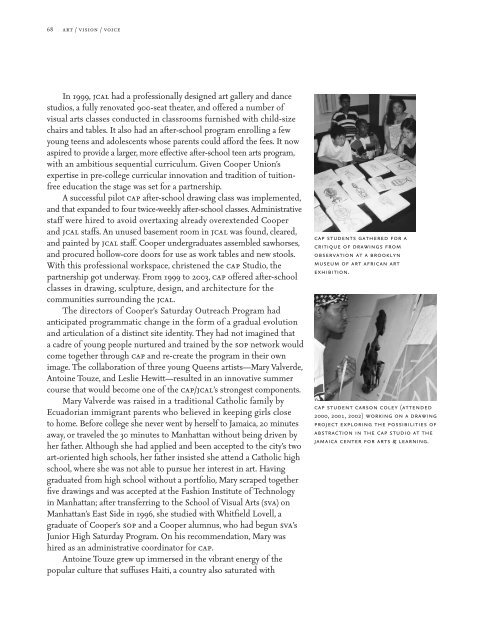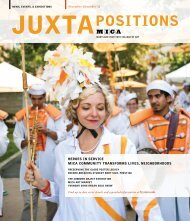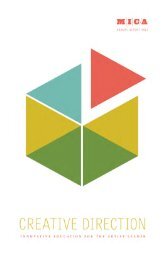art/vision/voice - Maryland Institute College of Art
art/vision/voice - Maryland Institute College of Art
art/vision/voice - Maryland Institute College of Art
Create successful ePaper yourself
Turn your PDF publications into a flip-book with our unique Google optimized e-Paper software.
68 <strong>art</strong> / <strong>vision</strong> / <strong>voice</strong><br />
In 1999, jcal had a pr<strong>of</strong>essionally designed <strong>art</strong> gallery and dance<br />
studios, a fully renovated 900-seat theater, and <strong>of</strong>fered a number <strong>of</strong><br />
visual <strong>art</strong>s classes conducted in classrooms furnished with child-size<br />
chairs and tables. It also had an after-school program enrolling a few<br />
young teens and adolescents whose parents could afford the fees. It now<br />
aspired to provide a larger, more effective after-school teen <strong>art</strong>s program,<br />
with an ambitious sequential curriculum. Given Cooper Union’s<br />
expertise in pre-college curricular innovation and tradition <strong>of</strong> tuitionfree<br />
education the stage was set for a p<strong>art</strong>nership.<br />
A successful pilot cap after-school drawing class was implemented,<br />
and that expanded to four twice-weekly after-school classes. Administrative<br />
staff were hired to avoid overtaxing already overextended Cooper<br />
and jcal staffs. An unused basement room in jcal was found, cleared,<br />
and painted by jcal staff. Cooper undergraduates assembled sawhorses,<br />
and procured hollow-core doors for use as work tables and new stools.<br />
With this pr<strong>of</strong>essional workspace, christened the cap Studio, the<br />
p<strong>art</strong>nership got underway. From 1999 to 2003, cap <strong>of</strong>fered after-school<br />
classes in drawing, sculpture, design, and architecture for the<br />
communities surrounding the jcal.<br />
The directors <strong>of</strong> Cooper’s Saturday Outreach Program had<br />
anticipated programmatic change in the form <strong>of</strong> a gradual evolution<br />
and <strong>art</strong>iculation <strong>of</strong> a distinct site identity. They had not imagined that<br />
a cadre <strong>of</strong> young people nurtured and trained by the sop network would<br />
come together through cap and re-create the program in their own<br />
image. The collaboration <strong>of</strong> three young Queens <strong>art</strong>ists—Mary Valverde,<br />
Antoine Touze, and Leslie Hewitt—resulted in an innovative summer<br />
course that would become one <strong>of</strong> the cap/jcal’s strongest components.<br />
Mary Valverde was raised in a traditional Catholic family by<br />
Ecuadorian immigrant parents who believed in keeping girls close<br />
to home. Before college she never went by herself to Jamaica, 20 minutes<br />
away, or traveled the 30 minutes to Manhattan without being driven by<br />
her father. Although she had applied and been accepted to the city’s two<br />
<strong>art</strong>-oriented high schools, her father insisted she attend a Catholic high<br />
school, where she was not able to pursue her interest in <strong>art</strong>. Having<br />
graduated from high school without a portfolio, Mary scraped together<br />
five drawings and was accepted at the Fashion <strong>Institute</strong> <strong>of</strong> Technology<br />
in Manhattan; after transferring to the School <strong>of</strong> Visual <strong>Art</strong>s (sva) on<br />
Manhattan’s East Side in 1996, she studied with Whitfield Lovell, a<br />
graduate <strong>of</strong> Cooper’s sop and a Cooper alumnus, who had begun sva’s<br />
Junior High Saturday Program. On his recommendation, Mary was<br />
hired as an administrative coordinator for cap.<br />
Antoine Touze grew up immersed in the vibrant energy <strong>of</strong> the<br />
popular culture that suffuses Haiti, a country also saturated with<br />
cap students gathered for a<br />
critique <strong>of</strong> drawings from<br />
observation at a brooklyn<br />
museum <strong>of</strong> <strong>art</strong> african <strong>art</strong><br />
exhibition.<br />
cap student carson coley (attended<br />
2000, 2001, 2002) working on a drawing<br />
project exploring the possibilities <strong>of</strong><br />
abstraction in the cap studio at the<br />
jamaica center for <strong>art</strong>s & learning.
















